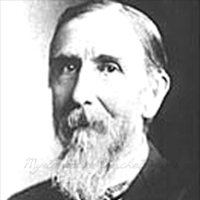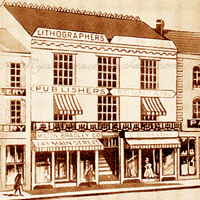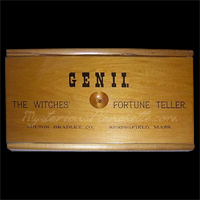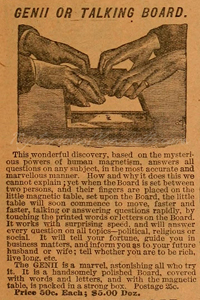One of the legends of the toy business, it comes as little surprise that Milton Bradley's company designed and marketed their own fortune telling device during the surge of popularity in such items with the introduction of the ouija board in 1892. Milton Bradley (1836 -1911) was a pioneer in the gaming industry, and his company is often credited for the introduction of the board game business in America. Bradley was a lithographer by trade, and set up his first lithography shop in Springfield, Massachusetts while still a young man.
Bradley's foray into the world of board games was a happy accident brought on by desperation. Bradley's firm had produced prints of then-presidential nominee Abraham Lincoln, but Honest Abe grew his distinctive beard out by the time the print run was completed. Retailers refused to by them and sent many back, and the company destroyed the remaining worthless stock by fire. Seeking to recoup his company losses, Milton Bradley found inspiration in an imported board game given to him as a gift, and in 1860 debuted The Checkered Game of Life. The first print run sold out in two days, and over 45,000 copies were sold in the first year, thus birthing Milton Bradley's gaming empire, which would go on to produce dozens of board games and educational toys, as well as such modern favorites as Candyland, Mouse Trap, and Battleship.
The year 1892 obviously marks one of the most significant milestones in commercial spirit communication devices, as Charles Kennard's "Ouija" talking board, patented the previous year, ignites a firestorm of popularity. Many toy companies were quick to jump on the coat tails of Kennard's success, including Milton Bradley. Alton Bullard-an employee of the company-is credited with the invention of the company's take on the talking board, which they called "Genii-The Witches' Fortune Teller." The Genii falls into the catch-all "dial plate" or general "talking board" category, and consists of a two-piece maple construction, with an inner sleeve that slides back and forth in the outer frame, not dissimilar to a slide rule. Users place their hands on the inner slide, whose movement is eased by the addition of several ball rollers in the outer frame, and spell out messages by viewing tiny numbers and letters through an equally tiny, eyestrain-inducing peephole. The product's name and tagline is largely emblazoned on the device's face...in an easy-readable font size that dwarfs the board's miniscule alphabet.
The Genii has much in common with the Aura: The Psychic Talking Board in both shape and function, though it is unknown which might have come first. They are very similar in shape, design, and function, though the Genii is certainly more complex as a device, with integrated rollers and the beveled peephole absent from the Aura, which instead relies on a simple socketed design and an arrow to point to letters and numbers on the item's periphery. Whatever their relationship, and whatever clues the Genii might hold to cracking the code, will have to wait for further discoveries!










